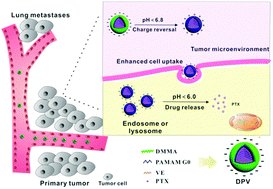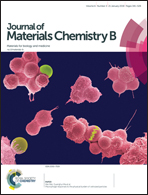pH-sensitive micelles with charge-reversible property for tumor growth inhibition and anti-metastasis†
Abstract
Physical properties, such as surface charge, of nanomedicines play a crucial role in their in vivo behaviors, which could eventually determine the tumor inhibition effect. Although drug delivery systems with positive charge are effective for cell internalization, this property is universally applicable to the lack of selectivity of both tumors and normal tissues, resulting in rapid blood clearance and undesired side effects. By employing charge-reversible strategies, the dilemma can be overcome and enhanced cellular uptake, prolonged circulation time and high biocompatibility can be realized. Here, we constructed Vitamin E-based micelles with charge-reversible property for the delivery of the antineoplastic agent paclitaxel. In the slightly acidic tumor microenvironment, the micelles converted from negative to positive charge due to the cleavage of the pH-sensitive bond, leading to enhanced cellular uptake and subsequently enhanced drug release. The micelles demonstrated improved antitumor efficiency both in vitro and in vivo and improved anti-metastasis effect in 4T1 orthotopic tumor model compared with those of clinically formulated Taxol and non-sensitive micelles. Besides, the micelles showed high biocompatibility and reduced side effects. Overall, these findings highlight that the micelles with charge-reversible property have great potential for cancer therapy in clinic.



 Please wait while we load your content...
Please wait while we load your content...